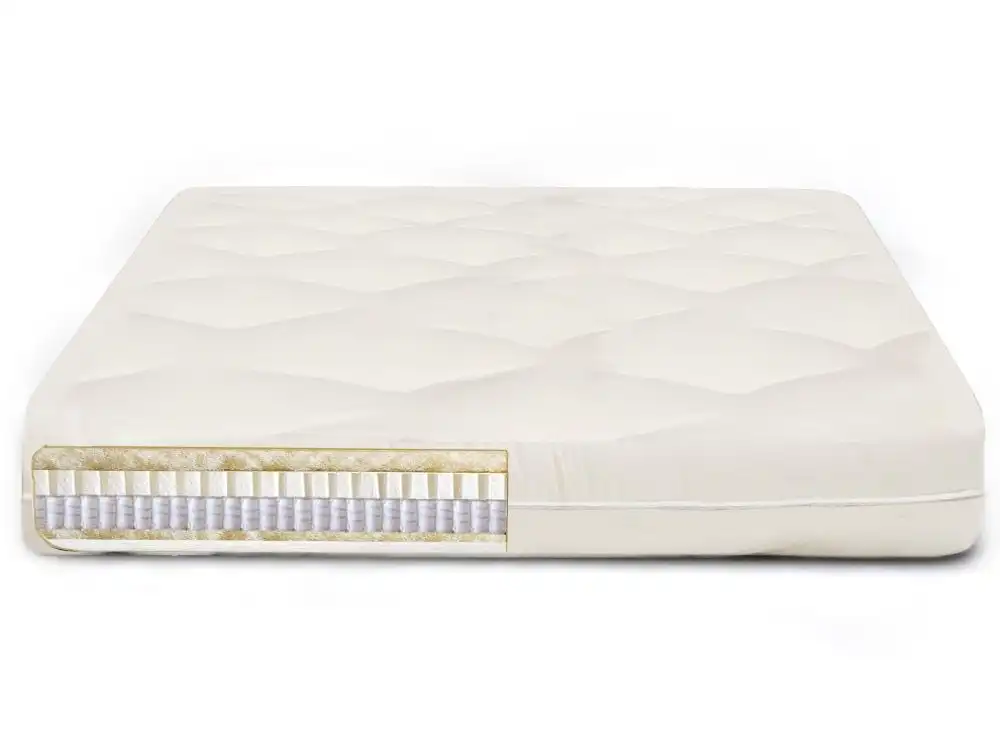- You are here:
- Home »
- Organic Mattresses »
- Can I Sleep on a Mattress on the Floor?
Can I Sleep on a Mattress on the Floor?
Sleeping on a mattress on the floor can be a great alternative to sleeping on a traditional bed. There are several pros and cons to consider before making a decision. We also include the best tips for those who want to give it a try. Here is a look at some of the key factors involved.

The benefits of sleeping on a mattress on the floor
While there are several benefits to sleeping on a mattress on the ground, one of the most appealing is the cost savings:
- A traditional bed can be quite expensive, especially if you opt for a higher-end model. A mattress on the floor, on the other hand, is a much more affordable option.
- In addition to being budget-friendly, sleeping on a mattress on the ground can also benefit your health. This sleeping surface is said to be better for your spine and can help to reduce back pain because it’s not as hard as a traditional bed frame.
- Using a mattress without a bed frame can make it easier to move around if you need to change locations. This can be especially helpful if you live in a small space or frequently move homes.
- Finally, placing a mattress on the floor can also benefit your mental health. This sleeping surface can help to promote a sense of grounding and calm. If you’re struggling with anxiety or stress, put a mattress on the ground to help you to feel more relaxed.
Read More: Best Organic and Natural Mattresses
The drawbacks of sleeping on a mattress on the floor
Of course, there are also some drawbacks to sleeping on a mattress placed on the floor:
- It can be less comfortable than a traditional bed. If you’re used to sleeping on a soft mattress with a plush pillow-top, you may find the floor to be too hard.
- It can also make it harder to get in and out of bed. This can be especially difficult if you have mobility issues. If the mattress is too low to the ground, you may find it challenging to get up from a seated or lying position.
- Another downside of putting your mattress on the floor is that it can make your bedroom look messy and cluttered. If you have a lot of stuff in your room, it can be difficult to keep everything tidy when there’s no bed frame to hide things away.
- It can also be colder than sleeping in a traditional bed. If your bedroom is not well-insulated or if you live in a cold climate, you may find that the floor is too chilly for comfortable sleep.
- Another thing to consider is that putting a mattress directly on the floor will limit the breathability of the mattress. This can lead to mold and mildew growth if the mattress is not properly ventilated. Limited air circulation may therefore ruin your mattress and your flooring over time.
- You may also find that insects, such as bed bugs or cockroaches, are more likely to enter your bed if you have a bed on the floor. If you live in an area with a lot of bugs, this could be a major downside.
- Finally, putting your mattress directly on the floor can also create more noise than sleeping on a traditional bed. If your floor is creaky or you live in an apartment with thin walls, you may find that there’s a loud noise every time you move. This can be disruptive for both you and your partner.

Read More: How to Store a Latex Mattress?
How to make the most of sleeping without a bed frame?
Putting your mattress directly on the floor is not as uncommon as one might think. In fact, it can be quite comfortable and even beneficial for your health! Here are a few tips to make the most of sleeping on a bed on the floor:
Disclaimer: As an Amazon Associate I earn from qualifying purchases.
1. Use a tatami mat.
A tatami mat is a type of mat used in traditional Japanese rooms. They are made of straw and sometimes, wood. Tatami mats are often used as flooring, but they can also be used to sleep on.
If you put a mattress on the floor, using a tatami mat can make it more comfortable. The mat will help evenly distribute your body weight and provide a bit of cushioning.
2. Use a mattress rug.
A mattress rug is a type of floor mat specifically designed to be used with a mattress on the floor. These rugs are usually made of coconut coir or other natural fibers and are thick enough to provide cushioning and comfort and allow air to circulate around the mattress.
3. Use a slatted bed base.
If you have a mattress that is intended for use on a bed frame, you can still use it on the floor. However, you will need to use a slatted bed base. This type of base allows air to circulate underneath the mattress and helps to keep it from getting too dirty or dusty.
4. Make sure the mattress is clean.
One of the most important things to remember when sleeping on a mattress on the floor is to ensure that the mattress is clean. If your mattress is not clean, you may end up with dust mites or other allergens.
5. Use a futon mattress.
Futon mattresses are often used in Japanese homes and can be a great option for sleeping on the floor. Futon mattresses are made of cotton or other natural fibers and are usually filled with latex, wool, or cotton batting.
The benefits of sleeping on a futon mattress include that they are soft and comfortable, provide good support, and are easy to clean. Their tufted surface also helps to keep them from slipping around on the floor and allows air to circulate.
Read More: Futon Mattress Sizes Chart
What’s the Best Organic Floor Mattress?
Organic materials are those that are grown without the use of synthetic pesticides, herbicides, or fertilizers. This means that they are better for your health and the environment.
An organic futon mattress is the best mattress type for sleeping on the floor. These mattresses are typically more durable than their non-organic counterparts since they are not treated with harsh chemicals that can break down the fibers over time.
Try EcoWool Futon Mattress made from GOLS-certified organic latex, GOTS-certified organic wool and USDA-certified organic cotton.
This mattress is free of harmful chemicals, flame retardants, and other toxins that can off-gas over time and negatively impact your health. It is also made from sustainable materials that will not end up in a landfill and can be composted or recycled.
FAQs about sleeping on a mattress on the floor
Is it safe to put a mattress directly on the floor?
There are no specific safety concerns about putting your mattress on the floor, but there are a few things to keep in mind. Make sure the mattress is firm and not too soft, so you don’t sink down and put strain on your back.
If possible, try to find a mattress with minimal give, such as an orthopedic mattress. You may also want to put something under the mattress to improve air circulation and avoid moisture build-ups, such as a slatted bed base or a tatami mat.
Read More: Best Japanese-Style Bed Frames
Will sleeping without a bed frame affect my back?
Sleeping on a too-soft surface can cause your spine to curve and lead to back and neck pain. A mattress on the floor is generally firm enough to avoid this problem, but if you’re concerned, consult a spine specialist before making the switch.
Is it comfortable to sleep on a mattress on the floor?
This is a matter of personal preference, but many people find it quite comfortable to sleep on the floor. If you have reduced mobility or are pregnant, sleeping on the floor may not be ideal.
However, if you’re healthy and have no trouble getting up and down from the floor, sleeping on a bed on the floor can be quite comfortable, but it may take some getting used to.
What are the benefits of sleeping on a mattress directly on the floor?
Placing a mattress on the floor has a few potential benefits:
- It’s usually cheaper than buying a bed frame and mattress set.
- It can be easier to move a floor mattress than a bed frame with a mattress, so it’s a good option if you’re frequently moving, as it will help you avoid back pain from lifting heavy furniture.
- Some people find it more comfortable to sleep on a mattress on the floor than in a bed, as it provides better support for your back and spine.
Are there any drawbacks to sleeping on a mattress on the floor?
The main drawback of putting a mattress on the floor is that sleeping can be less comfortable for many people, especially if you’re accustomed to sleeping on a mattress that’s supported by a bed frame.
If you have back pain or other medical conditions, talk to your doctor before making the switch. Additionally, mattresses on the floor are more likely to attract dust and dirt, so you’ll need to clean them more often.
On top of that, due to limited air circulation, mold and mildew can grow more easily on mattresses on the floor, so be sure to keep them clean and dry.
Finally, if you live in an area with earthquakes or other natural disasters, it’s important to secure your mattress to the floor so it doesn’t move around and possibly injure you during a shaking.

How do I choose a mattress for sleeping on the floor?
When choosing a mattress for sleeping on the floor, look for something firm but not too hard. You don’t want a mattress that’s so soft that you sink down and put a strain on your back, but you also don’t want one that’s so hard it’s uncomfortable.
If possible, try to find an orthopedic mattress or one with minimal give. Check your mattress warranty, as some manufacturers can void your warranty if you use the mattress on the floor. It may be safer to use a futon mattress designed for floor sleeping.
How do I clean a mattress on the floor?
Cleaning a mattress on the floor is similar to cleaning any other type of mattress. Start by vacuuming it to remove any dust and dirt. Then, use a
Is sleeping on a mattress on the floor safe if I’m pregnant?
There are no specific safety concerns about sleeping with your mattress on the floor during pregnancy, but you may want to talk to your doctor first. Sleeping on a firm surface can help relieve back pain, but if your mattress is too soft, it could make the pain worse.
Getting out of bed can also be more difficult when you’re pregnant, so you may want to consider using a bed frame or placing the mattress on a higher surface.
Can you put your mattress on the floor if you have allergies?
If you have allergies, you may want to avoid putting your mattress on the floor. Mattresses can collect dust and dirt, which can trigger allergic reactions. If you must put a mattress on the ground, try using an allergy-proof mattress protector and washing it regularly.
You can also develop allergic reactions to mold and mildew growth due to heat and moisture that can build up between the mattress and the floor. If you notice any mold or mildew on your mattress or the floor underneath it, clean it immediately and try to keep the area around the mattress as dry as possible.
Conclusion
Sleeping on a mattress on the floor can be a comfortable and cost-effective way to sleep, but it’s not for everyone. If you have back pain or other medical conditions, talk to your doctor before making the switch.
Additionally, mattresses on the floor are more likely to attract dust and dirt and promote mold and mildew growth, so you’ll need to clean them more often. So if you want to put your mattress on the floor, be sure to take the necessary precautions.
About the Author Kamila Flieger
My name is Kamila, and I'm passionate about researching non-toxic, organic products for the home. I believe it's so important to create a safe and healthy environment for our families, and I enjoy helping others do the same.


